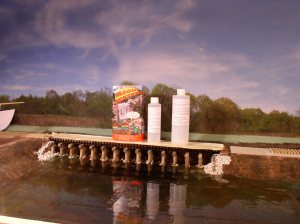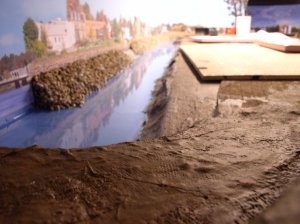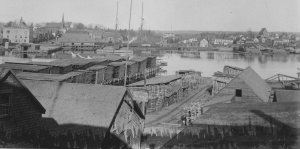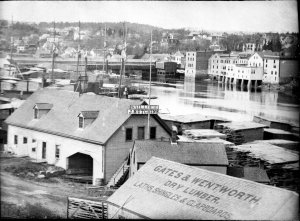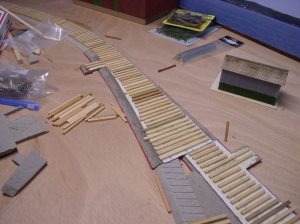Today I checked the results of the first layer of resin ‘water’. The Instant Water product was used in the Pennamaquan River feature. After 24 hours, it was still tacky. Perhaps tomorrow it will be finally cured and ready for another layer. This product is less viscous than the epoxy resin I have been used to. It mixes and pours easily. From an O Scale point of view I think it is too expensive for the area covered. It appears to be more ideal for the smaller scales. If you look closely you can see one of the plaster cloth seams that should disappear in the next pour. I have run out of the IW, so my regular resin will be used next.
For the St. Croix River I used a 1:1 epoxy product called Top Coat which was mentioned in the last post. Because of the viscosity it yielded a thicker coat. It also cured well in less than 24 hours. My observation is that the reflective color that I seek is still a bit too bright blue. I plan to cut in a bit of blue colorant in the next pour to try and tone it down a bit. Keep in mind that the effect I’m after is a live viewing effect and as a result it does not photograph as well as personally viewing it.
The next photo looks down the length of the river which is far too narrow compared to the actual river, but it is a necessary compromise. normal viewing is the photo above, not this one. The plywood sheet keeps me from damaging the yard track in Calais.
This next shot simply shows what the Top Coat product looks like. The 1:1 ratio is quite easy to deal with compared to the normal epoxy that has a more complex ratio. Those usually require special pumps to meter out the proper amount of both resin and hardener.
For both of the above products, mixing needs to be smooth, deliberate, and slow to minimize the amount of trapped air and to avoid bubbles. It usually takes about 5 minutes to be thorough. Any bubbles that do show up in the uncured resin can be removed by touching them with a pointed stick. Then they will flatten out nicely.
Ben

